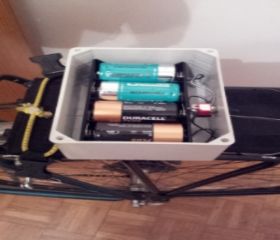2w is probably over kill, but has a good safety margin built in. It really depends if the light has a rectifier built in, it almost certainly does but it is possible to make an led light with out one.
This is going to look a bit like maths, sorry to any classics students reading.
Your resistor is governed by Ohm's law, VIR.
I is current in amps, you want between 0.4a and 0.6a depending on required battery life and how well heat sunk the body is. I'd guess not very well as a first pass.
V (voltage in Volts) in this case is the voltage drop you need across the resistor. This is the difference between the nominal voltage of the LED + the voltage dropped by any other components and the - the input voltage (batteries)
R (resitance in Ohms) = V/I.
To make this easy assume I = 500ma = 0.5a
the LED nominal voltage is 3.5v and any other diodes drop 1v.
If you have a recitifier V = (3.5+1)-4.8 = 0.3
R = V/I = 0.3/.05 = 0.6 ohms (round up) = 0.68R
Sans rectifier v= 3.5-4.8 = 1.3v
R = V/I = 1.3/.5 = 2.6 ohms (round up) = 2.7R.
To work out how big the resistor needs to be you need P=IV, P is power in watts, I is current again in amps, and V is voltage.
with rectifier P=IV = 0.5a x 0.3v = 0.015w round up 1/4w will be fine.
with out P=IV = 0.5 * 1.3 = 0.65 round up to 1w.
Worth noting these are nominal values the LED could drop more or less voltage as could the rectifier. Your battery voltage will come off the charger at more like 1.55v and drop to 1.2v after a little while but if you build in enough margin the high initial voltage will be fine. The current and thus the light output will not be linear but will ebb with the voltage of the batteries since the voltage drop across the resistor is setting the current.


 posts
posts
